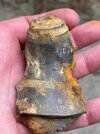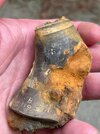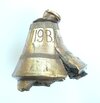Andy Naude
Well-Known Member
Received these three No 119 B & IV fuzes. I have a few questions.
1. Which calibre shells were fitted with these?
2. What the NZ stand for? (New Zealand)
3. Where all the No. 119 fuzes knurled in the centre? Or could it be an indication of a drill fuze?
4. What does the LZ stand for?
5. Why is the No 119 IV cut down?
Stamping: No 119 B Mk. 1 N.Z. 5/B P (the other R)
Stamping on the cut down fuze: LZ 45 3 33 I No.119 IV E CC 42 /I\





1. Which calibre shells were fitted with these?
2. What the NZ stand for? (New Zealand)
3. Where all the No. 119 fuzes knurled in the centre? Or could it be an indication of a drill fuze?
4. What does the LZ stand for?
5. Why is the No 119 IV cut down?
Stamping: No 119 B Mk. 1 N.Z. 5/B P (the other R)
Stamping on the cut down fuze: LZ 45 3 33 I No.119 IV E CC 42 /I\








